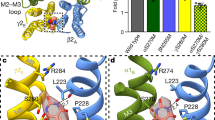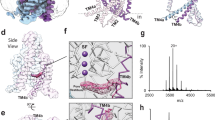Abstract
THE circumstantial evidence that anaesthetics act primarily by increasing the fluidity of membranes is quite strong. The gaseous, volatile, barbiturate, steroid and alcohol anaesthetics have all been shown to fluidise phosphatidylcholine–cholesterol lipid bilayers and the demonstration has also been made for some biological membranes1–4. Furthermore, a number of lipophilic substances, such as the higher alkanols, do not fluidise membranes and are not anaesthetics3. In some cases, a correlation between nerve-blocking potency and the action of anaesthetics in perturbing lipid bilayers has been observed5. Moreover, pressure counteracts the fluidising effects of anaesthetics just as it antagonises general anaesthesia in vivo6–9. The overall success of the fluidised lipid hypothesis tends to be its major drawback, for if anaesthetics fluidise membranes indiscriminantly then the hypothesis fails to provide a unique mechanism for their selective depression of neuronal function. We show here that lipid composition may modulate the ability of an anaesthetic to fluidise membranes more than has been generally supposed.
This is a preview of subscription content, access via your institution
Access options
Subscribe to this journal
Receive 51 print issues and online access
$199.00 per year
only $3.90 per issue
Buy this article
- Purchase on Springer Link
- Instant access to full article PDF
Prices may be subject to local taxes which are calculated during checkout
Similar content being viewed by others
References
Metcalfe, J. C., Seeman, P., and Burgen, A. S. V., Molec. Pharmac., 4, 87–95 (1968).
Trudell, J. R., Hubbell, W. L., and Cohen, E. N., Biochim. biophys. Acta, 291, 321–327 (1973).
Lawrence, D. K., and Gill, E. W., Molec. Pharmac., 11, 280–286 (1975).
Boggs, J. M., Yoong, T., and Hsia, J. C., Molec. Pharmac., 12, 127–135 (1976).
Johnson, S. M., Miller, K. W., and Bangham, A. D., Biochim. biophys. Acta, 307, 42–57 (1973).
Trudell, J. R., Hubbell, W. L., and Cohen, E. N., Biochim. biophys. Acta, 291, 328–334 (1973).
Johnson, S. M., and Miller, K. W., Nature. 228, 75–76 (1970).
Miller, K. W., Paton, W. D. M., Smith, R. A., and Smith, E. B., Molec. Pharmac., 9, 131–143 (1973).
Halsey, M. J., and Wardley-Smith, B., Nature, 257, 811–813 (1975).
Hubbell, W. L., and McConnell, H. M., J. Am. chem. Soc., 93, 314–326 (1971).
Rosenberg, P. H., Eibl, H., and Stier, A., Molec. Pharmac., 11, 879–882 (1975).
Neal, M. J., Butler, K. W., Polnaszek, C. F., and Smith, I. C. P., Molec. Pharmac., 12, 144–155 (1976).
McConnell, H. M., and McFarland, B. G., Ann. N. Y. Acad. Sci., 195, 207–217 (1972).
Seelig, A., and Seelig, J., Biochim. biophys. Acta, 406, 1–5 (1975).
Hale, J., Keegan, R., Smith, E. B., and Snape, T. J., Biochim. biophys. Acta, 288, 107–113 (1972).
Levitt, J. D., Anesthesiology, 42, 267–274 (1975).
Lever, M. J., Miller, K. W., Paton, W. D. M., and Smith, E. B., Nature, 231, 368–371 (1971).
Johnson, F. H., and Flagler, E. A., Science, 112, 91–92 (1950).
Paterson, S. J., Butler, K. W., Huang, P., Labelle, J., and Smith, I. C. P., Biochim. biophys. Acta, 266, 597–602 (1972).
Miller, K. W., Paton, W. D. M., Smith, R. A., and Smith, E. B., Anesthesiology 36, 339–351 (1972).
Whittaker, V. P., in Handbook of Neurochemistry, 2 (edit. by Lajtha, A.), 327–364 (Plenum, New York, 1969).
Gordesky, S. E., and Mannetti, G. V., Biochem. biophys. Res. Commun., 50, 1027–1031 (1973).
Tanaka, K-I., and Ohnishi, S-I., Biochim. biophys. Acta, 426, 218–231 (1976).
Metcalfe, J. C., Hoult, J. R. S., and Colley, C. M., in Molecular Mechanisms of General Anaesthesia (edit. by Halsey, M. J., Miller, R. A., Sutton, J. A.), 145–163 (Churchill Livingstone, Edinburgh, 1974).
Miller, K. W., Science, 185, 867–869 (1974).
Author information
Authors and Affiliations
Rights and permissions
About this article
Cite this article
MILLER, K., PANG, KY. General anaesthetics can selectively perturb lipid bilayer membranes. Nature 263, 253–255 (1976). https://doi.org/10.1038/263253a0
Received:
Accepted:
Published:
Issue Date:
DOI: https://doi.org/10.1038/263253a0
Comments
By submitting a comment you agree to abide by our Terms and Community Guidelines. If you find something abusive or that does not comply with our terms or guidelines please flag it as inappropriate.



